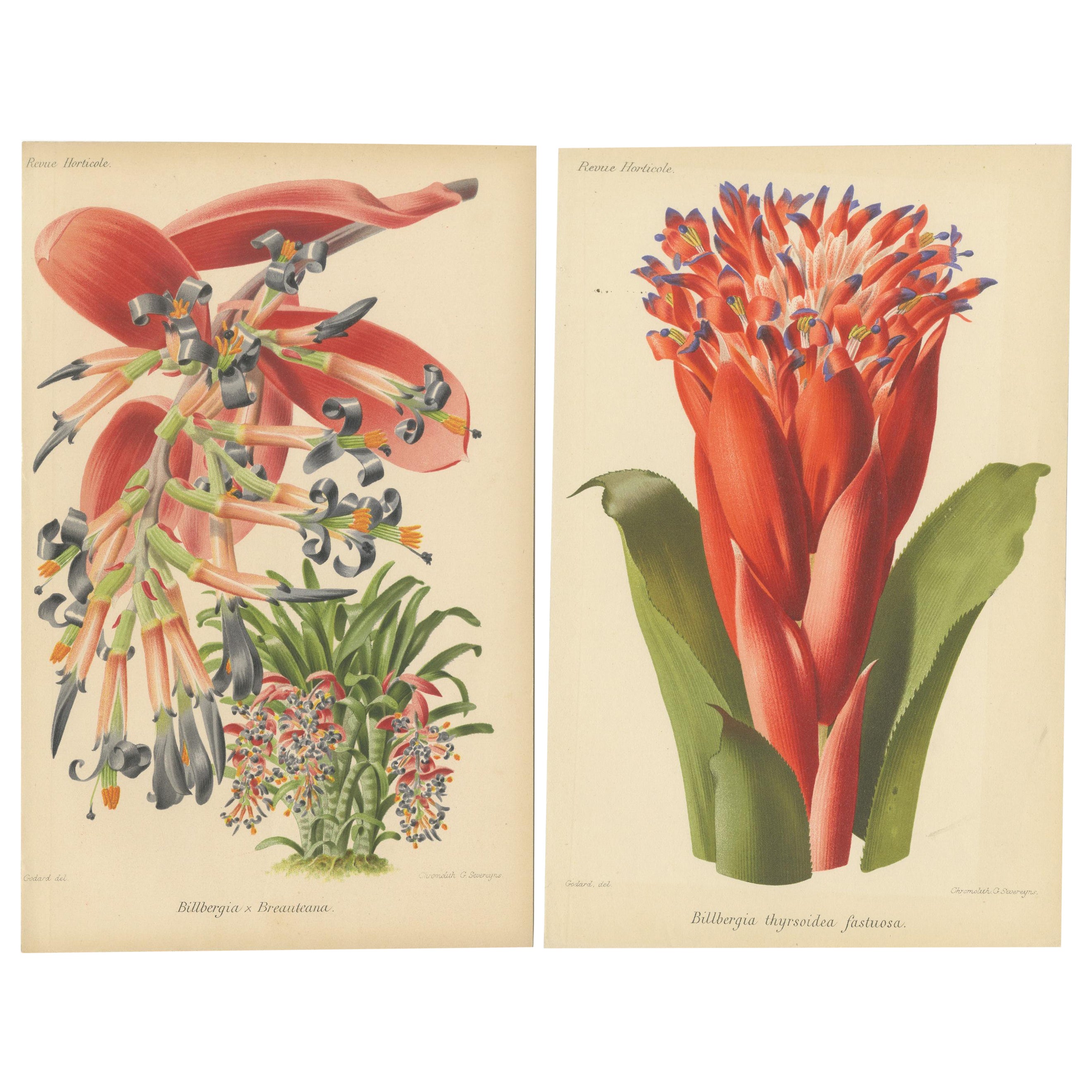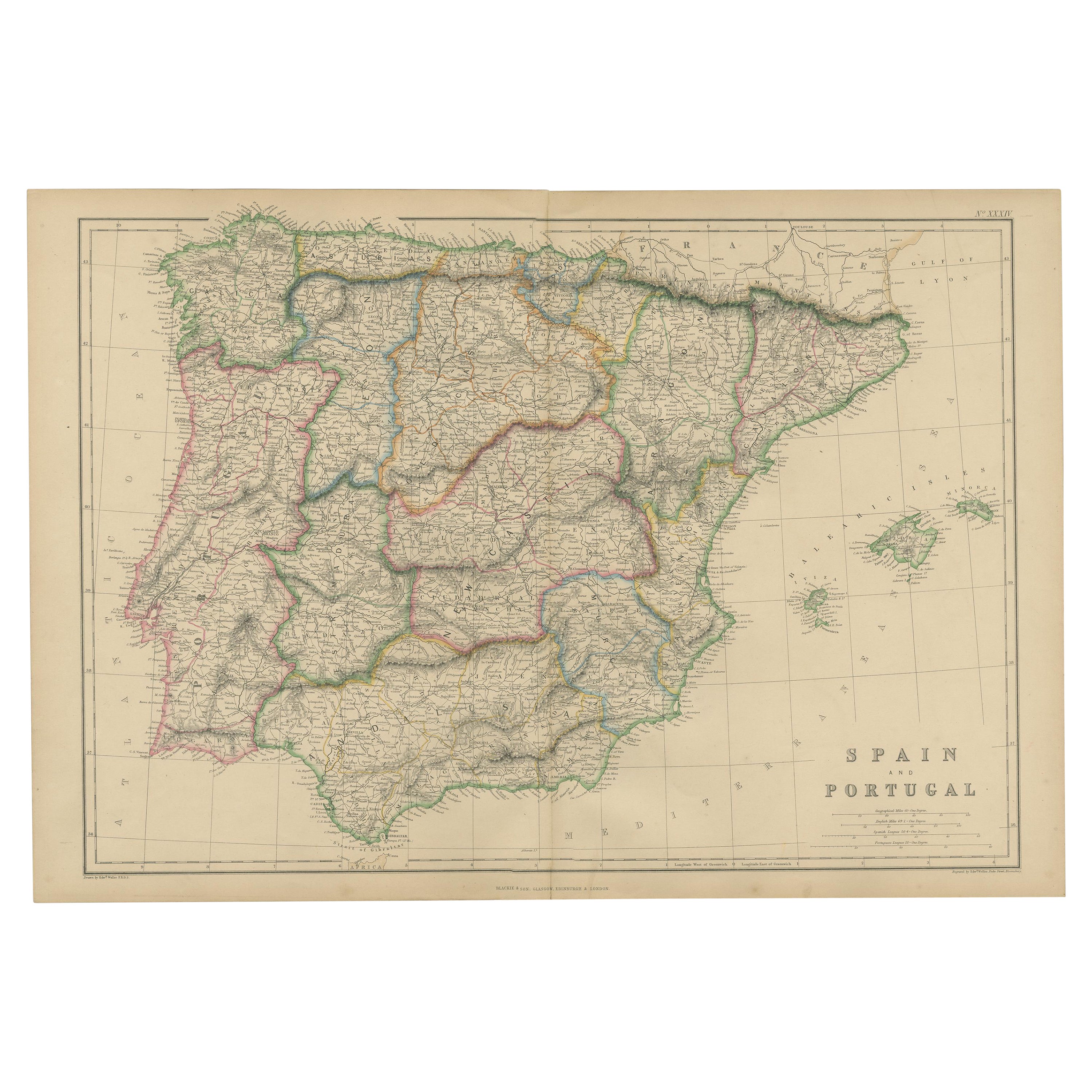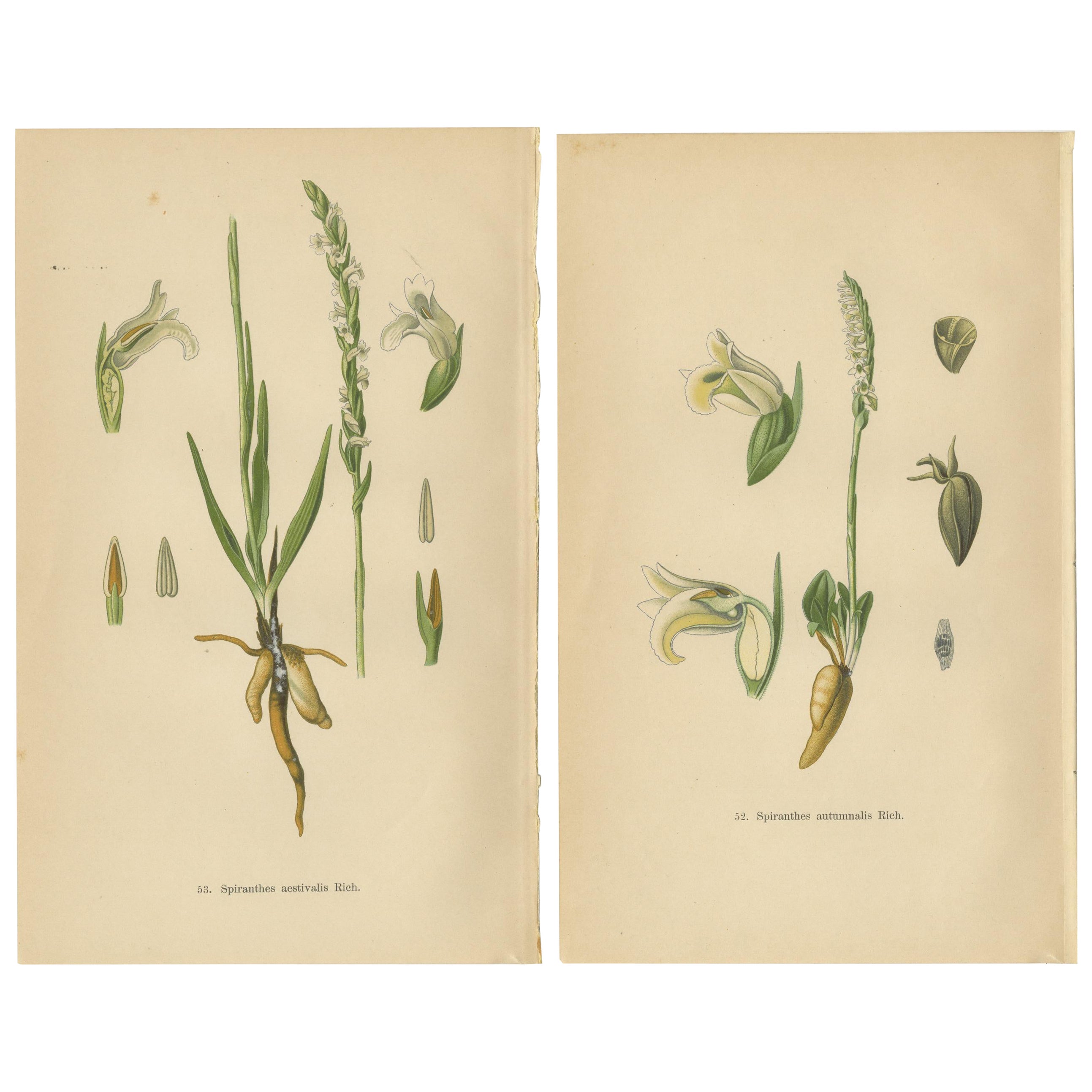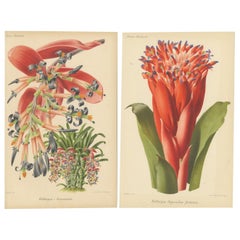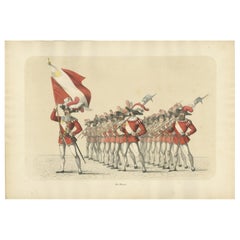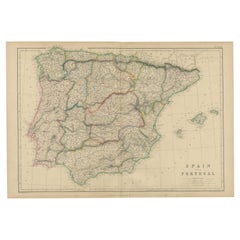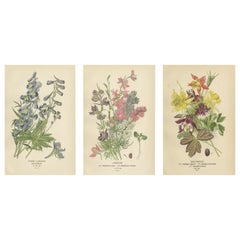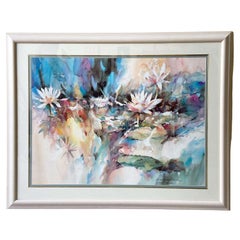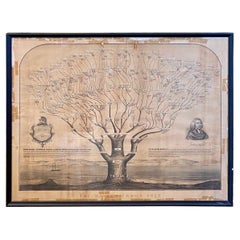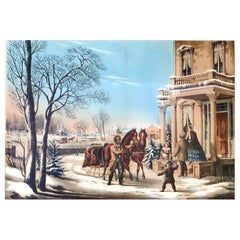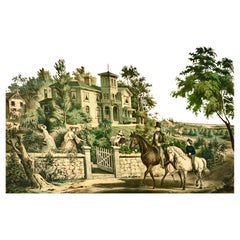Items Similar to Exotic Splendor: Hartweg's Sage, Flaming Torch, and Melinoni's Bromeliad, c.1855
Want more images or videos?
Request additional images or videos from the seller
1 of 6
Exotic Splendor: Hartweg's Sage, Flaming Torch, and Melinoni's Bromeliad, c.1855
About the Item
The prints are from "Revue Horticole," a prominent horticultural periodical known for its high-quality botanical illustrations, which served both educational and ornamental purposes. The illustrations were executed by the noted chromolithographer, P. de Pannemaeker or Severeyns, who were both key figures in the production of botanical art during the 19th century, often working for Belgian publications.
Details about the Maker, Publisher, and Publication:
- Maker: The chromolithographs were likely produced by P. de Pannemaeker or Severeyns, renowned for their expertise in chromolithography, a technique widely used in the 19th century for reproducing color in prints.
- Publisher: The publisher, "Revue Horticole," was a French journal that focused on the horticultural industry and botanical sciences, regularly featuring detailed botanical plates.
- Publication Date: These prints are from an unspecified volume but "Revue Horticole" was published in the 19th century, particularly thriving during the mid to late 1800s.
The three prints illustrate a selection of exotic plants, each unique in its floral architecture and horticultural appeal. Here is a closer look at each plant's identification and its botanical and cultural significance:
1. Hartweg's Sage (Stenomesson Hartwegi)
- Botanical Characteristics: This plant features elongated, slender green leaves with clusters of vibrant, tubular red flowers that dangle elegantly.
- Significance: Hartweg's Sage is admired for its striking flower display which adds a vivid splash of color to gardens. It is named after Karl Theodor Hartweg, a notable botanist and plant collector, reflecting its discovery during botanical explorations.
2. Flaming Torch (Kniphofia uvaria)
- Botanical Characteristics: Also known as Red Hot Poker or Torch Lily, this plant is famous for its bright, upright spires of densely clustered flowers that transition from fiery red at the top to yellow at the bottom.
- Significance: The Flaming Torch is a popular garden plant, particularly valued for its dramatic appearance and ability to attract pollinators such as hummingbirds. Its robust nature and striking inflorescence make it a favorite in ornamental horticulture.
3. Melinoni's Bromeliad (Aechmea melinonii)
- Botanical Characteristics: This bromeliad displays a large, dense cluster of star-shaped red flowers, surrounded by thick, fleshy green leaves.
- Significance: Native to tropical regions, Melinoni's Bromeliad is notable for its striking flower head and architectural foliage which make it an ideal candidate for tropical and subtropical gardens. It's also commonly used as an indoor plant due to its low maintenance needs and air-purifying qualities.
Broader Implications
These plants are not only significant for their aesthetic and ecological benefits but also for their role in the study of botany and the global trade of ornamental plants. Each species represents the botanical diversity explored during the 19th and early 20th centuries, often being featured in botanical magazines such as "Revue Horticole," which sought to document and share knowledge about rare and exotic plants from around the world.
Their inclusion in such detailed botanical illustrations also speaks to the era's advancements in botanical art, primarily through chromolithography—a technique that allowed these intricate details and vibrant colors to be reproduced faithfully, enhancing both scientific documentation and public appreciation of plant diversity.
Technique Used:
The technique used for these prints is chromolithography, a method for making multi-color prints. This process involves using multiple lithographic stones, each inked with a different color and carefully aligned to produce the final image. Chromolithography was celebrated for its ability to produce vibrant, detailed, and accurate representations of original artworks, making it particularly suited for detailed botanical illustrations like those in "Revue Horticole."
These factors combine to make the prints not only a beautiful artistic addition but also a valuable educational tool for those interested in botany and horticulture.
- Dimensions:Height: 9.85 in (25 cm)Width: 6.3 in (16 cm)Depth: 0 in (0.02 mm)
- Sold As:Set of 3
- Materials and Techniques:
- Period:
- Date of Manufacture:circa 1855
- Condition:Condition: Very good, given age. General age-related toning and/or occasional minor defects from handling. Please study scan carefully.
- Seller Location:Langweer, NL
- Reference Number:Seller: BG-13761-19, BG-13761-20, BG-13761-211stDibs: LU3054341424792
About the Seller
5.0
Recognized Seller
These prestigious sellers are industry leaders and represent the highest echelon for item quality and design.
Platinum Seller
Premium sellers with a 4.7+ rating and 24-hour response times
Established in 2009
1stDibs seller since 2017
2,412 sales on 1stDibs
Typical response time: 1 hour
- ShippingRetrieving quote...Shipping from: Langweer, Netherlands
- Return Policy
Authenticity Guarantee
In the unlikely event there’s an issue with an item’s authenticity, contact us within 1 year for a full refund. DetailsMoney-Back Guarantee
If your item is not as described, is damaged in transit, or does not arrive, contact us within 7 days for a full refund. Details24-Hour Cancellation
You have a 24-hour grace period in which to reconsider your purchase, with no questions asked.Vetted Professional Sellers
Our world-class sellers must adhere to strict standards for service and quality, maintaining the integrity of our listings.Price-Match Guarantee
If you find that a seller listed the same item for a lower price elsewhere, we’ll match it.Trusted Global Delivery
Our best-in-class carrier network provides specialized shipping options worldwide, including custom delivery.More From This Seller
View AllStunning Bromeliads: Queen's Tears and Flaming Torch in Artful Display, c.1855
Located in Langweer, NL
The prints are from "Revue Horticole," a prominent horticultural periodical known for its high-quality botanical illustrations, which served both educational and ornamental purposes....
Category
Antique 1850s Prints
Materials
Paper
Swiss March of Honor – The Thun Militia in Ceremonial Splendor, 1855
Located in Langweer, NL
1855 March of Honor – The Thun Militia in Ceremonial Splendor
This striking hand-colored lithograph, created by H. Jenny and lithographed by Kümmerly and Wittmer, is part of the *F...
Category
Antique 1850s Prints
Materials
Paper
Vintage Geographic Splendor: 1859 Spain and Portugal
Located in Langweer, NL
The "Vintage Geographic Splendor: 1859 Spain and Portugal" map is an original antique piece from 'The Imperial Atlas of Modern Geography', published ...
Category
Antique Mid-19th Century Maps
Materials
Paper
Botanical Elegance: A Triptych of Garden and Greenhouse Splendors, 1896
Located in Langweer, NL
"Botanical Elegance: A Triptych of Garden and Greenhouse Splendors"
Delight in the timeless allure of nature with our exquisite set of three original antique prints, "Botanical Elegance: A Triptych of Garden and Greenhouse Splendors". Culled from the esteemed 1896 publication "Favourite Flowers of Garden and Greenhouse" by Edward Step, these botanical illustrations epitomize the pinnacle of Victorian floral artistry.
Each print showcases a different beloved species, rendered in precise detail and subtle hues. The selection includes the stately Hybrid Larkspur (Delphinium), the charming Larkspurs (Delphinium ajacis and Delphinium orientale), and the enchanting Columbines (Aquilegia vulgaris, Aquilegia chrysantha, and Aquilegia formosa), all depicted in their natural size to capture their true beauty.
These prints are not mere reproductions; they are original works from the late 19th century, utilizing lithography—a technique that was the height of printing technology at the time. The meticulous hand-coloring applied after the initial printing process brings out the vibrant yet delicate colors of these florals, making each piece unique.
Whether for the collector of antique botanical art...
Category
Antique 1890s Prints
Materials
Paper
$315 Sale Price / set
20% Off
Free Shipping
Classical Greek Art Forms: Architectural and Ornamental Splendor, 1887
Located in Langweer, NL
Title: "Intricate Greek Artistry: Architectural and Decorative Elegance"
The prints showcase a variety of Greek artistic expressions focused on architectur...
Category
Antique 1880s Prints
Materials
Paper
Spiranthes Splendor: Vintage Botanicals from 1904
Located in Langweer, NL
The collage consists of two botanical illustrations from the book 'Abbildungen der in Deutschland und den angrenzende Gebieten vorkommenden Grundformen der ORCHIDEEN-ARTEN' by Walter...
Category
Antique Early 1900s Prints
Materials
Paper
You May Also Like
Aquatic Splendor, Framed & Signed Art Print by Brent Heighton
Located in Delray Beach, FL
Brent Heighton has been painting for over 42 years full time. After college Brent began a brief career in the commercial art field. Not satisfied with t...
Category
Vintage 1980s American Prints
Materials
Wood
19th Century Mayhew Family Tree from Nantucket and Martha's Vineyard from 1855
Located in Nantucket, MA
Very rare 19th century Mayhew Family tree from Nantucket and Martha's Vineyard, lithograph on paper laid on linen, printed in 1855, in form of liter...
Category
Antique 1850s American Other Historical Memorabilia
Materials
Linen, Paper
N. Currier Lithograph" Pleasures of Winter" American Country Life Series C.1855
By Currier & Ives
Located in Incline Village, NV
"Pleasures of Winter" Maintains the appropriate markings along with "New York, Published by N. Currier 152 Nassau Street.
(The firm was located here in lower Manhattan from 1837-1872)
The lithograph portrays a woman leaving her stately home with her two children, being escorted by two drivers to ride in a double seated horse drawn sleigh. In the background is a snowy field with other houses and a loaded horse drawn timber sleigh.
In addition to the Amon Carter Museum in Dallas, an example of "Pleasures of Winter" is in:
The Library of Congress
The Springfield Museum (Massachusetts) Gift of Lenore and Sydney Alpert)
Metropolitan Museum of Art (Gift of Colgate 1962)
Museum of Fine Arts Boston (Donated by Lee M. Friedman)
Dimensions: actual= 16 1/2" h x 23 13/16" w
matte= 19 1/2" h x 25 1/4" w
folio= 21 9/16" h x 27 1/2" w
with frame= 26 1/4" h x 32 1/4" w
frame= 1 1/4" burl bird's eye maple
It is in very good all original condition; and housed and professionally mounted in a fine quality and attractive bird's eye maple wooden frame with preservation backing and frontal protective glass (important when dealing with 170 year old lithographs); it is the rare and desirable Currier large folio sheet example in fine original color. There is minor foxing and a tideline upper center (see images).
The larger folios are more rare because they appealed to the wealthier sector of the population and were more expensive, thus fewer were made, albeit, knowing their more discerning customer base, there was more attention given to detail; hand coloring, and quality for example. This example has been framed and housed in museum quality conservation backing for over 80 years. I have had it professionally taken apart and I inspected the folio visually, and examined it with a black light and loop; as a result, I guarantee and can attest to the accuracy of my description of the lithograph. I then had the folio professionally remounted in it's original frame with an upgraded preservation backing (see images of original folios out of frame and for confirmation of inspection). This lithograph has no tears, no touch up paint, and no glued or taped repairs.
This is one of the four iconic and highly desirable set of lithographs made by Nathaniel Currier (1813-1888) dated 1855 from the American Country Life series. They are named;
Spring "May Morning";
Summer "Summer Evening";
Fall ""October Afternoon"; and
Winter "Pleasures of Winter".
The lithograph was produced from the painting of well known artist Frances (Fanny) Flora (Bond Palmer (1812-1876). She painted typical American scenes of daily American life that were used by Currier for years to come. She was an accomplished artist by the time she migrated to the United States from England, and Currier commissioned her to do the country scenes for this series. Each of the original images are toned lithographs with applied hand painted watercolor.
The lithograph reflects an affluent life style, showcasing grandiose homes and glamorizing the rural way of living as urban areas became more densely populated with the tidal wave and arrival of immigrants. Nathaniel Currier began his lithograph business in 1835 with hand colored images portraying outdoor panoramic, historical, pastoral, and landmark scenes and events, with which the middle class and the wealthy sought to decorate their houses. James Ives (1824-1895) was his accountant) and would join him later in 1857 to help run the business.
The hand painted lithograph is embellished with script text in the bottom margin of the folio "Entered according to art of congress in the year 1855 by N. Currier in the clerk's office of the southern district of N.Y."
"F.F Palmer...
Category
Antique 1850s American Victorian Prints
Materials
Paper
Nathaniel Currier Lithograph "May Morning" American Country Life Series C. 1855
By Currier & Ives
Located in Incline Village, NV
This lithograph portrays a pleasant scene of a man in a top hat atop a handsome dark horse, with a boy riding a white horse (presumably father and son) in front of a country estate, while women gather as they water flowers, and children play with a lamb in the foreground. A man plows a field; while a horse is being groomed near the stable in the background. Afar and to the right is the sea dotted with ships here and there. The folio is mounted on cardboard and set in the matte.
It is in very good all original condition; and housed and professionally mounted in a fine quality and attractive bird's eye maple wooden frame with preservation backing and frontal protective glass (important when dealing with 170 year old lithographs); it is the rare and desirable Currier large folio sheet example in fine original color. There is some toning and slight fading,
The larger folios are more rare because they appealed to the wealthier sector of the population and were more expensive, thus fewer were made, albeit, knowing their more discerning customer base, there was more attention given to detail; hand coloring, and quality for example. This example has been framed and housed in museum quality conservation backing for over 80 years. I have had it professionally taken apart and I inspected the folio visually, and examined it with a black light and loop; as a result, I guarantee and can attest to the accuracy of my description of the lithograph. I then had the folio professionally remounted in their original frame with an upgraded preservation backing (see images of original folios out of frame and for confirmation of inspection). This lithograph has no tears, no touch up paint, and no glued or taped repairs.
This is one of the four iconic and highly desirable set of lithographs made by Nathaniel Currier (1813-1888) dated 1855 from the American Country Life series. They are named;
Spring "May Morning";
Summer "Summer Evening";
Fall ""October Afternoon"; and
Winter "Pleasures of Winter".
The lithograph was produced from the painting of well known artist Frances (Fanny) Flora (Bond Palmer (1812-1876). She painted typical American scenes of daily American life that were used by Currier for years to come. She was an accomplished artist by the time she migrated to the United States from England, and Currier commissioned her to do the country scenes for this series. Each of the original images are toned lithographs with applied hand painted watercolor.
The lithograph reflects an affluent life style, showcasing grandiose homes and glamorizing the rural way of living as urban areas became more densely populated with the tidal wave and arrival of immigrants. Nathaniel Currier began his lithograph business in 1835 with hand colored images portraying outdoor panoramic, historical, pastoral, and landmark scenes and events, with which the middle class and the wealthy sought to decorate their houses. James Ives (1824-1895) was his accountant) and would join him later in 1857 to help run the business.
The hand painted lithograph is embellished with script text in the bottom margin of the folio "Entered according to art of congress in the year 1855 by N. Currier in the clerk's office of the southern district of N.Y."
"F.F Palmer...
Category
Antique 1850s American Victorian Prints
Materials
Paper
Set (4) Nathaniel Currier Lithographs American Country Life--Four Seasons C1855
By Currier & Ives
Located in Incline Village, NV
It is rare to have the opportunity to acquire all four of these scenes at once, especially in this very good all original condition; and housed and professionally framed in fine quality and attractive bird's eye maple wooden frames with preservation backing and frontal protective glass (important when dealing with 170 year old lithographs); all are the more rare and desirable large folio sheet examples in fine original color.
The larger folios are more rare because they appealed to the wealthier sector of the population and were more expensive, thus fewer were made, albeit, knowing their more discerning customer base, there was more attention given to detail; hand coloring, and quality for example. All examples had been framed and housed in museum quality conservation backing for over 80 years. I have had each one professionally taken apart and inspected visually and examined with a black light and loop; as a result, I guarantee and can attest to the accuracy of my descriptions of each folio. I then had the folios professionally remounted in their original frames with an upgraded preservation backing (see images for viewing original folios out of frame and for confirmation of inspection).
When available these lithographs are typically acquired individually, in varying condition, and often unframed. Other examples are often reproductions or "tear out sheets" from coffee table type books. These lithographs have no tears, no touch up paint, and no glued or taped repairs.
This iconic and highly desirable set of four lithographs by Nathaniel Currier (1813-1888) dated 1855 from the American Country Life series depicts;
Spring "May Morning";
Summer "Summer Evening";
Fall ""October Afternoon"; and
Winter "Pleasures of Winter".
All four images are produced from the paintings of well known artist Frances (Fanny) Flora (Bond Palmer (1812-1876). She painted typical American scenes of daily American life that were used by Currier for years to come. She was an accomplished artist by the time she migrated to the United States from England, and Currier commissioned her to do the country scenes for this series. Each of the original images are toned lithographs with applied hand painted watercolor. The series of four reflects affluent life styles in each of the four seasons by showcasing grandiose homes and glamorizing the rural way of living as urban areas became more densely populated with the tidal wave and arrival of immigrants. Nathaniel Currier began his lithograph business in 1835 with hand colored images portraying outdoor panoramic, historical, pastoral, and landmark scenes and events, with which the middle class and the wealthy sought to decorate their houses. James Ives (1824-1895) was his accountant) and would join him later in 1857 to help run the business.
Each of the hand painted lithographs is embellished with script text in the bottom margin of the folio "Entered according to art of congress in the year 1855 by N. Currier in the clerk's office of the southern district of N.Y."
"F.F Palmer...
Category
Antique 1850s American Victorian Prints
Materials
Paper
Nathan Currier Lithograph "October Afternoon" American Country Life Series C1855
By Currier & Ives
Located in Incline Village, NV
"October Afternoon" Maintains the appropriate markings along with "New York, Published by N. Currier 152 Nassau Street.
(The firm was located here in lower Manhattan from 1837-1872)
The lithograph illustrates two men and their dog with young son (hunting rifle over shoulder) in tow, returning from the rabbit hunt with their catch being presented to the lady of the house with baby in arms. The gated mansion is in the background while geese float upon the fertile pond in the background.
In addition to the Amon Carter Museum in Dallas, an example of "Pleasures of Winter" is in:
The Metropolitan Museum of Art (Bequest of Adele S. Colgate, 1962)
Museum of Fine Arts Boston (Donated by Lee M. Friedman)
The Library of Congress
The Yale University Art Gallery (Gift of Mabel Brady Garvan Collection)
Dimensions: actual= 16 1/2" h x 23 13/16" w
matte= 19 1/2" h x 25 1/4" w
folio= 21 1/4" h x 27 3/4" w
with frame= 26 1/4" h x 32 1/4" w
frame= 1 1/4" burl bird's eye maple
It is in very good all original condition; and housed and professionally mounted in a fine quality and attractive bird's eye maple wooden frame with preservation backing and frontal protective glass (important when dealing with 170 year old lithographs); it is the rare and desirable Currier large folio sheet example in fine original color. There is some slight foxing to the cream border and minor fading (see images),
The larger folios are more rare because they appealed to the wealthier sector of the population and were more expensive, thus fewer were made, albeit, knowing their more discerning customer base, there was more attention given to detail; hand coloring, and quality for example. This example has been framed and housed in museum quality conservation backing for over 80 years. I have had it professionally taken apart and I inspected the folio visually, and examined it with a black light and loop; as a result, I guarantee and can attest to the accuracy of my description of the lithograph. I then had the folio professionally remounted in it's original frame with an upgraded preservation backing (see images of original folios out of frame and for confirmation of inspection). This lithograph has no tears, no touch up paint, and no glued or taped repairs.
This is one of the four iconic and highly desirable set of lithographs made by Nathaniel Currier (1813-1888) dated 1855 from the American Country Life series. They are named;
Spring "May Morning";
Summer "Summer Evening";
Fall ""October Afternoon"; and
Winter "Pleasures of Winter".
The lithograph was produced from the painting of well known artist Frances (Fanny) Flora (Bond Palmer (1812-1876). She painted typical American scenes of daily American life that were used by Currier for years to come. She was an accomplished artist by the time she migrated to the United States from England, and Currier commissioned her to do the country scenes for this series. Each of the original images are toned lithographs with applied hand painted watercolor.
The lithograph reflects an affluent life style, showcasing grandiose homes and glamorizing the rural way of living as urban areas became more densely populated with the tidal wave and arrival of immigrants. Nathaniel Currier began his lithograph business in 1835 with hand colored images portraying outdoor panoramic, historical, pastoral, and landmark scenes and events, with which the middle class and the wealthy sought to decorate their houses. James Ives (1824-1895) was his accountant) and would join him later in 1857 to help run the business.
The hand painted lithograph is embellished with script text in the bottom margin of the folio "Entered according to art of congress in the year 1855 by N. Currier in the clerk's office of the southern district of N.Y."
"F.F Palmer...
Category
Antique 1850s Victorian Prints
Materials
Paper
